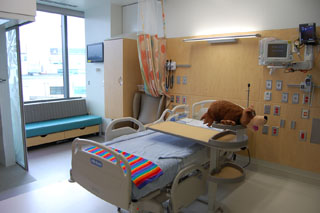|
Subscribe / Renew |
|
|
Contact Us |
|
| ► Subscribe to our Free Weekly Newsletter | |
| home | Welcome, sign in or click here to subscribe. | login |
Construction
| |
 |
April 17, 2013
How to create spaces that help children heal
ZGF Architects

Rossen
|
The importance of design as a way to enhance the quality of healing for patients and their families is well understood.
Studies show that integrating families into the delivery of care, providing nurturing spaces with access to daylight and views and other supportive strategies, increases recovery rates and a general sense of well being. These principles are called evidence-based design because they are quantifiable and research-based solutions for enhancing well-being while minimizing potential sources of patient stress, medical errors and the spread of infections.
A new twist to the story of enhanced care is called lean — a care-delivery strategy that aims to improve outcomes by standardizing care and removing waste from the process. Lean principles, first adopted for the automotive industry, are seen more frequently in the health care field because of the positive outcomes it supports.
Lean design is a commitment to continuous improvement and waste reduction while meeting the needs of each patient, providing the highest quality of care. Continuous improvement means that spaces must be highly flexible allowing for care team and patient care spaces to be reconfigured with a minimum of effort.
A lean environment supports the flow of information, equipment and supplies in a smooth and orderly way. Tools and equipment used in the delivery of care are highly visible, allowing for ease of use and assessment of stock flows.
A good example of this is access to supplies, both clean and soiled, without the extra step of having to open a cabinet door. Cabinet doors pose not only an extra step in flow, they are also a surface that has the potential to harbor harmful germs.
The challenge is designing a space that both supports the restorative qualities of healing and provides maximum visibility, flexibility and access to supplies.
The support of evidence-based design strategies and lean organization can seem mutually exclusive. In the case of Building Hope, it was essential that the expansion be designed for a high degree of flexibility and transparency, requiring the design team to think about the organization of the spaces in a very specific way.
Flexible furniture
Wherever possible, systems furniture and flexible solutions are used to provide for easy reconfiguration and change of use. With the exception of one code-required room with full-height, traditionally constructed walls, all of the structures in the care team spaces are composed of full-height glass demountable partitions and a post-and-beam desking system.
Power and data can easily be updated, added or moved. As care delivery models change, adjustments to the space can be carried out with a minimal amount of effort and expense, providing significant cost savings.
Headwalls and footwalls in the patient rooms are a rail-based system that allows for the addition or modification of care-supportive tools, supplies, power and data, as well as patient and family comforts such as storage cabinets and display shelving.
A small refrigerator, storage for dry food, suitcases and other comforts from home can be stored in adaptable cabinets that hang from the components of the rail-based system, allowing those components to be switched out over time or with a change in use of the room. For example, a short-term care unit can be easily adapted into a long-term care unit by simply sliding on additional storage components.
Families are encouraged to stay overnight with their children, so this provides for their needs and comfort as well. A variety of seating and sleeping solutions such as padded tops on movable storage units and a small, durable table that doubles as seating allows for larger groups, friends and families to visit comfortably.
A place for everything
Clutter is the biggest challenge to maintaining a nurturing, relaxed environment.
Spaces that require supplies to be visible and accessible need a strategy for the organization of these supplies in a way that provides a built-in system to encourage alignment and organization. “A place for everything and everything in its place” philosophy ensures that clutter is minimized.
Slat walls in specific places where supplies are mounted to walls ensure that tools and supplies will be organized into a contained area. “Off stage” parking areas for equipment keeps the corridors and patient rooms as clean as possible. Mobile supply carts have a specific space within the unit and the room for clear organization.
Lowering the volume
Environments that are designed for a high degree of flexibility and visibility are typically open and use a lot of glass. This makes containing noise levels in a busy patient unit challenging.
In a lean environment, a layered approach to acoustics ensures that both privacy and a sense of calm are maintained. Highly efficient ceiling systems, rubber flooring, cork flooring in family spaces, fabric-wrapped acoustical wall panels and plenty of soft seating help to mitigate the negative effects of noise, which are shown to hinder the quality of patient experience and recovery time.
Roles for art
The need to enhance privacy in a space mostly constructed of glass walls was addressed through the use of custom-designed art applied in films and transparencies onto the glass doors and partitions.
Animals and textures supporting a forest theme in Building Hope are incorporated in a way that allows natural light to flow through the space while minimizing direct lines of sight into patient rooms.
Within the patient room, artwork is designed to engage, using detail and pattern to bring whimsy and discovery to kids of all ages. The artwork in the corridors is more textural to discourage lingered engagement with the motifs.
Natural light
Evidence-based design research shows that natural light reduces depression, enhances healing and reduces the intake of pain medication. In the new building, expansive windows and a narrow floor plate allow daylight to penetrate as far into the unit as possible.
Natural light is controlled by a two-part shading system allowing for views or full blackout for daytime sleeping. The amount of windows accessible from all areas of Building Hope allow for the space to be bathed in the healing qualities of natural light and connection to the natural world.
Lighting-control system
Evidence-based design shows that when artificial lighting mimics day and night light cycles, children will sleep easier and gain weight faster.
The strategy for lighting design within the building layers a range of light sources. Indirect, dimmable fixtures in all areas of care provide blended illumination with a minimum of glare and the harsh effects of artificial lighting.
A carefully planned lighting-control system allows for patients and families to adjust lighting levels inside the patient room to create a variety of moods and support a wide variety of activities. Corridor lighting is controlled to follow the natural circadian rhythms, cycling up and down at dawn and dusk.
Patient-controlled colored LED lighting (with six color options) is used in patient rooms and lounges to create a sense of whimsy and delight and enhance the sense of control patients often need to maintain their psychological well-being.
Colors that pop
The color palette of Building Hope is intentionally neutral to give the space a warm and restful quality in a space with large amounts of metal and glass.
Combined with doses of white, the neutral palette enhances the effect of the colored LED lighting by providing a neutral, reflective surface. Bright pops of color throughout accent the neutral backdrop, and reinforce Seattle Children’s identity.
Health care-specific antimicrobial fabrics and finishes provide a safe environment for patient and support long-term maintenance. All traditional wall protection and obtrusive crash rails were eliminated to avoid reinforcing a utilitarian, institutional feel. Instead, full height, impact-resistant textural and colored panels serve the dual purpose of adding warmth and wall protection.
Flooring and color transitions provide movement and pattern in corridors, assist with wayfinding, and offer a visual cue to families and staff that marks isolation gowning zones at patient room entries.
Today’s health care delivery strategies are more sophisticated than ever, as is the thinking that goes into the design of the clinical environment.
Advances in research-based understanding of the effects of our external environment on the quality of healing and general well-being, and the application of process-improvement strategies borrowed from manufacturing are important aspects of modern health care facilities design. Their application and goals may seem mutually exclusive at times and do provide challenges to hospitals and designers interested in providing for the highest quality of care and patient experience.
Seattle Children’s Hospital is especially committed to the positive aspects of providing the right solutions to ensure safe and secure spaces for all their patients.
Anita Rossen is a senior interior designer at ZGF Architects with experience creating functional and innovative interior design solutions for health care projects.
Other Stories:
- Ultra-efficient mechanical systems offer lots of ways to cut costs
- Hospital design started with yarn, cardboard and duct tape
- A unique to-do list: move 68-ton tree and play Where’s Waldo with kids



